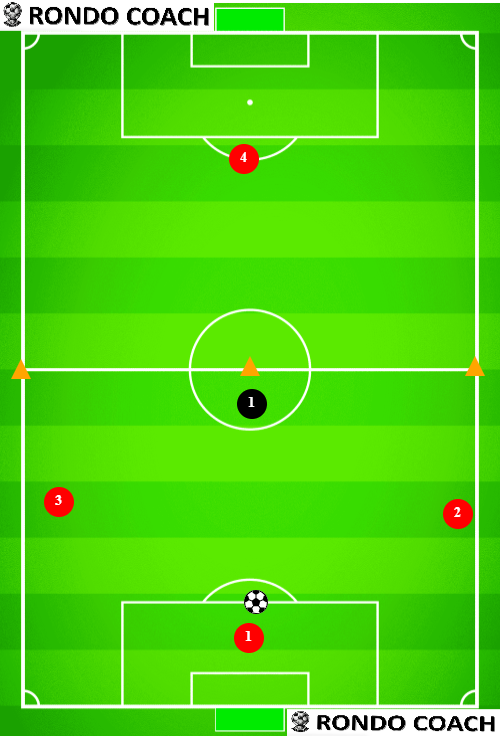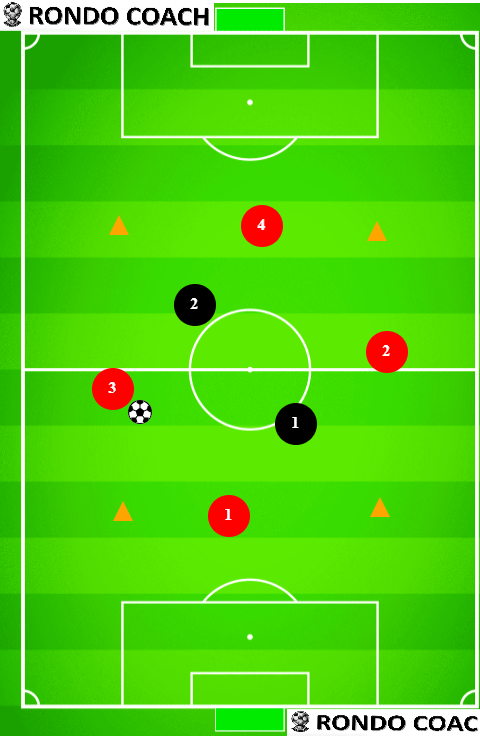3v1 Rondo [Complete Guide with Variations]
One of the natural points between 4v1 and 4v2 rondos is to have a 3v1 rondo. It’s a simple rondo where three players try to retain possession of the ball while one player tries to intercept it. At the highest levels, this is a warmup drill often, while more players are trickling in. Instead of having a 6v2 rondo, it is better to have two 3v1 rondos with players having many more touches on the ball. After all, the aim is to develop the technique and positional awareness of the players, especially at young ages.
Why do the 3v1 rondo?
While designing soccer drills, we want them to be game-like, challenging and used as building blocks. The 3v1 rondos has only 4 players, so they are relatively simple and quick to set it up. With the increased intensity from 4v1, we bridge the gap to the next level at 4v2. At 4v1 the player with the ball has three passing options, but at 4v2 they have only two. However, the number of players pressing doubles from one player to two. If we can remove the second variable, then at 3v1 we have only one presser, but we still have only two passing options. This way of gradually increasing intensity is why the 3v1 rondo is a great stepping stone.
We will explore several variations of the 3v1 rondos. Firstly, it’s just the traditional 3v1 without much complexity. However, we want to keep it fun, so we’ll do a few more. The transition rondo where there are two playing boxes and we have 3v1 plus 1 transition, can make things interesting for your team. Also, one of my favorites is the 3v1 converting to 5v3 rondo. Keep in mind that the 5v3 rondo can be challenging for your team, so we’ll go through tricks on how to ease into it.
3v1 Rondo

This is the first block of 3v1 rondo. The players have already done 4v1 rondos, so they understand the basic idea. However, now we tell them that there are four sides of the square and three players, so what happens? Some people prefer making a triangle to limit the movement, but I like to use this interesting situation. One option is to give them the freedom to move wherever they want. If they get good enough, I ask them something different. The new rule is that they cannot play on the same side twice. This is particularly useful for them to get into a pass-and-go mindset. So the rule is very simple – pass, then go to an adjacent side. If that side is already occupied, that’s okay. The teammate can either move or still receive the ball and quickly pass it to you. It will not only improve the movement of the passer but of the other teammates, too.
3v1 -> 5v3 Transition Rondo

This is much more complicated rondo and I recommend it after being proficient in 5v2 and 4v2 rondos. The reason is that 5v3 rondo is really about developing the central midfielder at a very high level. They start by being in defense against 3 players, then they recover the ball and they are the glue in the middle of it all. It’s particularly difficult in transition. If the field is small, then the 5v3 will be difficult. If the field is large, then 3v1 is hard for the defender. Ideally, you would start with a small inner and large outer playing field. However, over time they should both be small. The end goal is to have about 7 by 7 steps for the inner and 12 by 12 for the larger area.
The 4 players on the outside will learn off-the-ball movement and anticipation of the interception. As we said, their teammate will learn the central midfielder role both in defense and offense. The positioning and one-touch will drastically improve by practicing that drill. The team of 3 players will develop a quick transition from offense to defense. That is also part of anticipation, but it is a different kind of skill to anticipate how to quickly recover the ball once it’s lost. Also, they will practice team pressing, unlike the defender in the middle. One more note: rotate the player in the middle every several minutes. If they are practicing well, they will be so tired of pressing strong in defense and moving off the ball in offense.
Conclusion
We’ve covered the 3v1 rondo and several variations of it. Don’t forget that the simple versions are just stepping stones of it and your players will likely outgrow them quickly. However, the more complex ones, especially the 3v1 to 5v3 transition can take a very long time to get good at. We use the rondos to create a game-like situation to teach particular skills. In this case, we coach pressing, ball retention, first touch, passing as well as transitions. They are fantastic building blocks that shouldn’t be skipped and we should be deliberate and thoughtful when using them to develop our players. Have fun coaching!
RONDOS
No Opponents Rondo
Introduction to rondos with 3v0 and 4v0. Coaching passing, receiving, and the concept of “backfoot”.
First opponent
Introduce an opponent in the rondo. Create the need to move off the ball and think of passing lanes.
Increase intensity
Limit one passing option, and improve decision-making. Put pass-and-go into practice. Introduce a transition rondo to 5v3.
Increase complexity
Introduce team pressing of two players. Coach the central midfielder for the first time.
Pro Rondo
The rondo that pros play. Teaching to split the opponents with the right weight of the pass.
Positional play
All variations of the complex rondos before transitioning into positional play and game scenarios.















